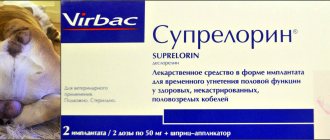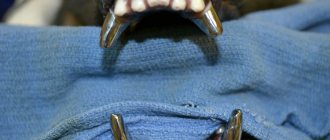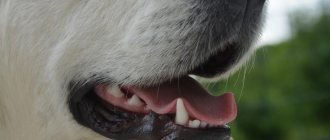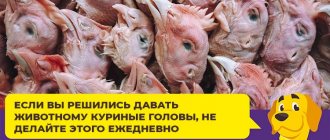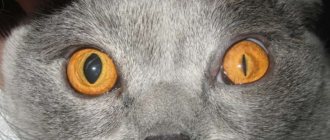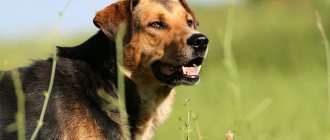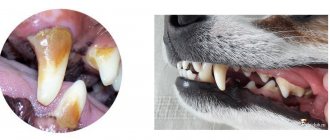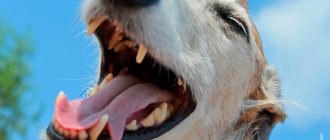Correct bite. Snack. Underbite.
Bite in dogs is the relationship between the dentition of the upper and lower jaw.
The type of bite in a dog is determined by the nature of the closure of the dentition and can be of four types: scissor-shaped (“scissors”), straight (“pincers”), overshot, undershot. The bites listed above depend on the length and position of the jaws. In addition, the bite can change for various reasons, and be, for example, floating (a temporary phenomenon in puppies due to a soft, undeveloped jaw), skewed (improper tooth growth, trauma, congenital anomalies) or alveolar (improper inclination of the teeth) .
Chinese crested bite
The normal bite of a Chinese Crested dog is described by the standard as a scissor bite (or, as dog lovers call it, “scissors”). With this type of bite, the upper canines slightly cover the lower ones. In this case, the lower canines should enter the interdental space between the upper extreme incisor and the upper canine, but the surfaces of the teeth should not touch.
CORRECT BITE
DIRECT BITE
Straight bite in an adult dog
CHILDREN'S UNDERBITE
The bite should be formed by the age of 45-50 days (about 1.5 months) - at the time of activation of the puppy. Sometimes, however, there are puppies whose lower jaw seems to be slightly pushed back. This is the so-called “children’s underbite” or it is also called “deep bite”.
The reason for puppy underbite can be explained very simply - baby teeth are very small and take up relatively little space on the jaw. The gap that remains between the jaws, and which is so similar to an underbite, is free space for larger molars. As you grow, after changing teeth, this deficiency is corrected without any intervention.
Children's underbite, which will improve with age
UNDERBITE
Underbite is a pronounced gap between the incisors of the upper and lower jaw. Underbite is an unacceptable form of bite for the Chinese Crested. Such dogs should be excluded from breeding activities and sold without the right to participate in exhibitions and breeding.
A very severe underbite can cause the fangs of the lower jaw to injure the gums of the upper jaw. In this case, it is recommended to remove the lower canines and the dog can lead a normal life. Underbite no longer affects the dog's health in any way.
Since we are talking about underbite, dogs also have another form of overbite - compensated underbite. Compensated underbite is characterized by some shortening of the lower jaw in combination with an alveolar inclination of the incisors and canines. Thus, the lower jaw is significantly shorter than the upper jaw, but the incisors and canines on the lower jaw are located at such an angle that they come into contact with the upper teeth and form a tight scissor bite.
SNACK
An underbite is a form of bite in which the incisors of the lower jaw are located in front of the incisors of the upper jaw (the so-called “bulldog” or “bulldog jaw”). Overbiting is an unacceptable form of overbite for a Chinese Crested. Such dogs should be excluded from breeding activities and sold without the right to participate in exhibitions and breeding.
A very pronounced undershot can be noticeable when looking at the dog’s face - the lower jaw protrudes, the tongue or fang sticks out. In this case, you can remove the protruding teeth, or contact a veterinary dentist.
Very often, a puppy’s malocclusion can form when the owner allows the change of baby teeth to molars to happen. Due to impaired tooth growth, the puppy’s teeth change process incorrectly and an incorrect bite is formed. For example, a primary canine does not allow the molar to grow properly, which causes the molar to move the incisors. Read the article - Changing baby teeth in a puppy.
Types of malocclusion
It is possible to detect jaw deformation in a dog starting at the age of 4 months, when the baby teeth change.
Dog handlers distinguish four main types of abnormal changes in dogs.
Straight
It is characterized by complete closure of the lower and upper incisors along one line. Leads to premature wear of the incisors. In this case, food is chewed poorly, which affects digestion and absorption of essential nutrients.
Children's undershot
Underbite is observed in puppyhood. It is characterized by a slight deviation of the lower jaw backward relative to the upper jaw. As a rule, it corrects itself when baby teeth are replaced with permanent ones.
Diagram of a dog's teeth seen from the front
Diagram of teeth seen from the side
Snack (progenia)
Overshot manifests itself in a slight protrusion of the lower incisors and canines forward relative to the upper ones. This deviation is the standard for the Boxer, Bulldog, Pekingese and Shih Tzu breeds. For other dogs, this is a pathology.
Underbite
It is characterized by a significant protrusion of the upper incisors in front of the lower ones. This pathology is clearly disqualifying for exhibitions and breeding.
An incorrectly formed bite can be corrected when the dog is between 5 and 12 months old.
Any deformations of the teeth and jaws negatively affect the digestive processes
Consequences of malocclusion in dogs
In each individual case, the need and expediency of correction must be determined by a veterinarian. If we start from the facts, then the wrong consequences of a malocclusion in a dog, indeed, often lead to injuries to the palate, tongue, gums and other dental problems. And poor-quality chewing of food unnecessarily loads the digestive system.
But sometimes a slight deviation does not prevent the animal from living a full life and does not cause harm. Then there is no need to correct the bite. In any case, such dogs no longer participate in exhibitions and are not used for breeding.
How does the deviation develop?
- Games that put a lot of stress on your teeth. This mistake is often made by owners of fighting breed dogs, for some reason believing that from early childhood the animal should carry bricks, rays in its teeth or hang from a stick.
- Impaired development of the jaw and teeth can be caused by poor nutrition, or rather, a lack of minerals in the diet.
- Jaw trauma sustained in childhood often leads to impaired bone formation and changes in bite.
- And, of course, heredity plays an important role.
A dog that has even minor pathologies is not allowed to breed.
Puppies are always born without teeth. The first baby tooth appears only after a few weeks. True, in just two to three months the deciduous row is fully formed and has 28 teeth. Almost immediately the change from dairy products to indigenous ones begins.
At the age of 7-8 months, the animal should have a fully formed dentition, which consists of 42 permanent teeth. But in some animals this amount may be less, then they speak of partial teeth (oligodontia). If there are more teeth, then polyodontia or polyodontia.
Causes of malocclusion in dogs
If signs of deformation or a change in the defect in the dog’s teeth are detected, dog handlers will disqualify the representative of the breed. Therefore, if a puppy is purchased and raised for a show career and further breeding, careful attention must be paid to the teeth.
The main reasons for the formation of incorrect teeth position are:
- genetic predisposition. Dogs with improperly positioned teeth are discarded from breeding so as not to worsen the breed characteristics of future litters. Therefore, before purchasing a puppy, it is necessary to establish the fact that the descendants have the correct one;
- poor quality and unbalanced nutrition. A lack of vitamins and microelements necessary for the growth and development of teeth leads to disturbances in the structure of the teeth and jaw as a whole. To prevent pathology, the puppy must receive good nutrition appropriate for its age and be exposed to natural sunlight for up to two hours a day;
- metabolic disorders lead to improper absorption of nutrients entering the body and their subsequent deficiency. In addition to quality nutrition, the dog must receive daily physical activity in accordance with breed and age standards. It is also necessary to treat all diseases in a timely manner to prevent disruptions in the body’s functioning and subsequent complications;
- Violation of the schedule for changing baby teeth, in the form of premature eruption of molars when temporary teeth have not fallen out, leads to displacement and curvature of new permanent teeth. If deviations occur in the schedule for changing teeth, it is necessary to visit a veterinarian to correct the situation;
- injuries to the jaw, such as blows, strong pressure (when a dog digs its teeth into something and pulls hard), gnawing hard objects (for example, bones) also causes curvature of the teeth and jaw. The puppyhood period is the most important period in the development of a dog's bite. Until all of the dog’s single-rooted teeth grow out, it is necessary to observe safety measures to injure the jaw (do not play tugging with objects with the puppy, do not allow the puppy to gnaw on bones or other hard substances, try to avoid possible injuries). In case of jaw injury, you should immediately contact a veterinarian for examination.
When assessing a dog’s exterior, dog handlers always look to see if its jaws and teeth are connected correctly.
Correct and incorrect bite in dogs
First, let's get acquainted with the norm. The small teeth that are located between the canines are called incisors. Fangs and incisors are used to capture food. Immediately following the canines are the premolars and molars, or molars. Their function is to chew.
The correct bite in dogs is scissor bite.
, is the standard for most breeds. When the jaws are closed, the lower incisors slightly extend beyond the upper ones, and the canines are in close contact with each other, while the lower canine should fit into the gap between the upper and the incisor. If we talk about malocclusion, there are several types:
- Underbite – the lower jaw is underdeveloped or the upper jaw is overdeveloped, which is why the lower incisors do not touch the upper ones.
- Overshot - the lower jaw is longer, and, accordingly, the lower incisors protrude forward. For some breeds, such as boxers, shih tzus, French and English bulldogs, this overbite is normal.
- Direct bite (pincer-shaped) - when, when the jaws are closed, the surfaces of the teeth touch end-to-end. This leads to premature wear and early loss of teeth.
- An open bite is when the mouth is closed and the teeth do not touch.
- Crooked bite is considered a severe hereditary defect and appears when one side of the jaw develops faster. One of the lower canines is often displaced inward and causes damage to the upper palate.
How is bite correction in dogs carried out and why is the anomaly dangerous?
A person with braces is no longer surprising, but when we see a dog with braces on its teeth, many of us may not believe our own eyes. Meanwhile, correcting the bite in dogs is a necessary procedure not only for show pets, but also for four-legged pets, because first of all, the health of the animal depends on the correct closing of the jaws. An abnormal bite in a dog can cause periodontal disease, accelerated tooth wear, and digestive problems. You will learn from the article about what bites are like in dogs, how to determine the presence of an anomaly, and what correction methods are available in modern veterinary dentistry.
2 style=”text-align: center;”>Bite in a dog: how to recognize an anomaly?
The bite of dogs, like people, is the relationship of the upper and lower jaws when they are completely closed. There are several types of bite in dogs.
Normal or orthognathy (also called a “scissor bite”): in dogs, this relationship of the dentition is considered natural, allowing the jaws to perform the functions assigned to them: tearing meat, cracking bones, capturing prey. This type of bite is physiologically correct.
Scissor bite in dogs (photo below) received this name due to the fact that the jaws, when fully closed, do not have a gap between themselves, similar to the blades of scissors. The incisors of the lower dentition are located behind the upper front teeth, located close to them.
The photo shows a scissor bite in dogs.
Abnormal types of bite include:
- straight (the second name is pincer-shaped): when the jaws close, the front incisors come into contact with the cutting edges of each other, which increases the load on them and leads to accelerated abrasion of enamel and dentin; at the same time, the chewing teeth often do not touch their cusps, which is why the dog chews food poorly and may suffer from indigestion;
- progenia or underbite (also known as bulldog bite): with this anomaly, the lower jaw protrudes forward relative to the upper jaw; Mostly dogs with short muzzles suffer from the pathology;
- prognathic (known as underbite): the upper incisors overlap almost the entire height of the crown of the lower incisors, the lower jaw appears underdeveloped.
Important: malocclusion in a dog is a relative concept. For each breed it may have different criteria. Thus, for boxers and bulldogs, progeny is considered the norm, while for other breeds it is an anomaly.
3 style=»text-align: center;»>Causes of malocclusion in dogs
The main cause of malocclusion in dogs is heredity. However, in addition to genetic predisposition, other factors could influence the correct closing of the dog’s jaws:
- violation of the timing of the loss of baby teeth: if the baby tooth falls out untimely, the permanent tooth does not have the opportunity to grow correctly and grows outside the dentition;
- chewing on too hard objects (this primarily concerns the period of teething): owners should purchase special rubber toys for the animal that will not injure the pet’s teeth;
- mechanical impact: with careless and too active games (for example, tugging with a stick), there is a risk of injury to the pet’s teeth; even such, at first glance, harmless punishment of the animal as poking its nose into a puddle can negatively affect the bite;
- unbalanced diet: a lack of minerals and vitamins in a puppy’s diet can lead to brittle teeth, their destruction and further malocclusion;
- incorrect placement of cords and bridles: to prevent the jaws from being squeezed by the lips, short bridles must be trimmed for the pet in puppyhood;
- incorrect number of teeth: a dog may have both supernumerary teeth and an insufficient number of them.
Playing too aggressively can cause bite problems.
2 style=»text-align: center;»>Bite correction in dogs
For modern veterinary orthodontics, an abnormal bite in a dog is a solvable problem. Veterinarians note that recently, owners of four-legged pets have been coming to the clinic with this problem more often, as more methods have appeared for correcting a dog’s bite.
Dog in braces.
The sooner orthodontic treatment is started, the higher its effectiveness. However, an adult dog can also be cured.
Important: correction of the bite can only be done after the animal’s growth process has finished: for dogs of dwarf breeds this is 11 months, and for large animals - after 15 months.
3 style=»text-align: center;»>Orthodontic treatment methods for dogs
There are 2 main methods for correcting a dog’s bite:
- installation of a bracket system;
- wearing clear aligners.
We recommend reading what causes the tongue to turn burgundy.
Find out what are the symptoms of viral stomatitis and how to cure it.
Braces are a permanent metal structure that is attached to the front surface of the animal's teeth. Correction of a dog's bite occurs due to the fact that the arch is given the correct shape of the jaw and it gradually moves the teeth in the right direction.
The second option is removable structures - transparent aligners. They are made from casts of the animal's jaws. Impressions are taken under anesthesia, as they must be as accurate as possible. The aligners move the teeth, putting pressure on them. Approximately once every 3 months, the mouthguard is replaced with a new one, which has a different shape from the previous one.
3 style=”text-align: center;”>How do dogs cope with bite correction?
It is impossible to explain to an animal that the installation of an orthodontic structure is a necessary measure. And of course, the dog is not able to provide intensive care to the teeth during the treatment period. This becomes the owner's first priority. Therefore, it is impossible to compare orthodontic treatment in animals and humans.
All dogs react differently to treatment, but in most cases, adaptation to a foreign object occurs within a couple of days. Some animals need to wear a post-operative collar to prevent injury. During the period of adaptation of the pet to the braces system or aligners, the owner must show increased attention and care to it.
Transparent mouth guards for correcting malocclusion in dogs.
During the entire treatment period, the owner needs to thoroughly brush the dog’s teeth and monitor the pet’s diet. The dog’s diet should not contain food that can damage the braces system and injure the animal’s gums.
If you suspect a dog has an incorrect bite, the first thing you need to do is take your pet to the veterinarian. Anomalies in jaw closure not only affect the dog’s face, but also have a negative impact on his health. Due to non-closing of the jaws, the dog may have constant drooling, the eating process will become difficult, and the animal may be unable to eat accurately.
Read: how dental restoration is performed with composites.
We advise you to read about basal implants and their features.
Find out how Kameton works for a sore throat.
Crooked teeth are less easily cleaned naturally from food debris, which leads to increased deposition of tartar on them, the development of caries, gum inflammation, and stomatitis. A protruding fang can rub the mucous membrane, resting against it when the jaws close and forming a chronic injury that causes pain to the animal. A loving owner should understand how serious a problem a dog’s malocclusion can become, and if an anomaly is detected, contact a specialist.
Bite correction in dogs
What to do if you decide to cure your dog’s malocclusion? Veterinary orthodontics is a branch of dentistry that specializes in the prevention of bite pathologies and studies possible treatment methods. Some breeders say that the bite can be corrected through massage.
But let's face it, this is stupid. Neither a massage of the upper jaw nor a massage of the lower jaw in any way affects the position of the teeth, much less the development of the bone. Correcting the bite is the task of an orthodontist in veterinary practice; if an incorrect bite requires the intervention of a doctor, removable and non-removable systems are used. Fixed staples or braces, similar to those used in medical dentistry. Special locks are fixed on the enamel and connected with a tensioned wire, thus creating the necessary pressure on the tooth, which corrects its direction. During the entire period of wearing the system, the doctor, as necessary, changes the tension of the plates.
Bite after wisdom tooth removal
In modern man, wisdom teeth are an atavism, that is, an element that seems to be there, but is not required in life. They do not affect the correct closure of the teeth and do not harm the dentition in any way if they erupted correctly. This is why dentists recommend not touching wisdom teeth and not removing them unless necessary.
But if you decide to form the correct bite of your teeth as an adult, useless “eights” can serve you well. The fact is that after their removal, the dense dentition becomes freer, so that the remaining teeth can be positioned correctly.
Malocclusion as a source of health problems in dogs
Full health of a dog means the good condition of all its organs and systems, including teeth. Unfortunately, these friendly animals, which have served man faithfully for a long time, have not been spared many “human” diseases. One of them is an incorrect bite in a dog.
For breeding puppies or service breed dogs, this disease becomes a death sentence, excluding the right to serve or breed. In addition, this deficiency greatly affects the dog’s overall health.
Consequences of malocclusion for a dog's health
The chewing apparatus is the beginning of the gastrointestinal tract. Therefore, disturbances in its structure inevitably affect the functioning of the digestive system:
- difficulty in eating and chewing food causes gastrointestinal disorders;
- severe malocclusion can cause oral injuries;
- loose jaw closure leads to constant drooling, which means the appearance of weeping eczema and dermatitis.
At the same time, if minor deviations from the norm do not worsen the quality of life of the animals, then correcting the bite in dogs may not be necessary.
In any case, the final decision on further actions must be made by a veterinarian orthodontist.
Problems caused by malocclusion
Malocclusion in people almost always leads to quite serious problems, and not only with the oral cavity. Among the consequences of incorrect closure of the dentition are:
- Increased stress on teeth, which leads to premature tooth loss. It is possible to develop periodontal disease, which accelerates the process. As a result, by the age of 40-50 a person is left without teeth.
- Unpleasant gum sensitivity. The gums begin to react to hot and cold foods, and often unsightly and painful ulcers form on them.
- Disease of the temporomandibular joints. It is also caused by excessive stress, since it is this organ that compensates for the absence of some teeth. It all starts with discomfort, pain, clicking sounds and tingling in the masticatory muscles. Next, your head will begin to hurt systematically, and changes in appearance may also appear.
- Problems with the gastrointestinal tract. There are many types of gastrointestinal diseases that appear due to poorly chewed food. The lack of necessary processing of food entering the stomach leads to excessive stress on the organ, and its strength limit is not infinite.
- Psychological consequences. A person sees a flaw in himself and this creates uncertainty, an inferiority complex, low self-esteem, modesty, timidity and other psychological problems.
Remember that the formation of a correct bite is a matter of health, and not just a solution to aesthetic problems. This is why it is so important to see a dentist on time.
Important! If a child has a malocclusion on his baby teeth, it must also be treated! Although the teeth will be replaced over time, they will grow in the same places where their milk predecessors were. In addition, in childhood the body adapts faster and recovers more easily, so treatment will be faster.
Types of bite
Let's consider what types of bites exist (from normal to pathological) and what evil can be expected from the incorrect arrangement of teeth.
The main functions of dog teeth are:
- Capturing prey. It is carried out by fangs and incisors. Four fangs (2 on each jaw) have an elongated, slightly curved shape. Between them there are smaller incisors.
- Chewing food. This task is performed by molars (premolars and molars). They are located at the back, behind the fangs.
Normal bite
Normal bite (orthognathia) is also called scissor bite. When the mouth is closed, the lower incisors should press closely against the back of the upper incisors. A scissor bite ensures normal chewing of food, protects the soft tissues of the oral cavity from traumatic disorders, and ensures normal retention of prey.
Purebred dogs that have deviations from this form of jaw closure are always mercilessly disqualified and not allowed for breeding. The reason for this strictness is that bite defects often begin to form as a result of genetic disorders. This pathology can be inherited.
Pathological bite
There are several options for pathological bite:
- A straight (pincer) bite is sometimes considered a normal variant. The incisors of the lower and upper jaws touch with their cutting edges. In this position, these teeth are subject to a large load for which they are not designed. The disadvantage of this bite is the rapid grinding of the incisors. The remaining teeth are not affected.
- Undershot (prognathia). A shortened lower jaw causes the incisors to not touch each other. Canines, premolars and molars take on the entire load, which leads to their rapid wear. Undershot is considered a disqualifying characteristic for all dog breeds without exception.
- Snack (progenia). The peculiarity of the structure of the muzzle is such that the lower jaw protrudes far forward, opening the incisors. Bulldogs and boxers have this skull structure. Therefore, for dogs of these breeds, snacking is not a defect.
- Asymmetrical bite. Formed when one side of the jaw is more developed than the other. May be a common cause of health problems. This is a disqualifying sign that applies to all breeds of dogs.
- Open bite. It is formed due to improper growth of the incisors, which do not close at all when the jaws are closed.
Teeth and bite
Bite is the relative position of the teeth of the upper and lower jaw. The bite is one of the most important indicators of a dog’s exterior. The correct bite for each breed is determined by the standard.
Depending on the form of closure of the teeth, it is customary to distinguish several types of bite in dogs: scissor bite, underbite, pincer bite, and overshot bite.
Scissor bite
Most breeds have a scissor bite (normal bite), where the upper row of incisors covers the lower incisors so that the lower incisors touch the inner surface of the upper incisors. It provides the least wear on teeth and a strong grip.
Scissor bite in lock
This bite forms a strong and secure “lock” when the lower canines are located directly between the outer incisors and the upper canines. There should be no contact between the canines and any other teeth. The edges of the upper and lower premolars should be mutually spaced like the teeth of a gear. A scissor bite is also characteristic of wild canids.
Normally, the incisors close vertically and extend deeply beyond each other. Sometimes the closure of the incisors does not occur vertically, but at a greater or lesser inclination (alveolar inclination).
A scissor bite does not prevent teeth from being misaligned. Breeders must understand and pay attention to the fact that along with the scissor bite, the canines, premolars and molars must also be positioned correctly. It often happens that premolars or molars are in an overbite or underbite position, despite a scissor bite between the upper and lower incisors.
Anomalies of a scissor bite include situations in which the jaws close normally, but one or more teeth have an altered position in the dental arch. Such anomalies in a typical case are not due to genetic reasons. However, some syndromes are common in certain breeds (eg, mesial displacement of the maxillary canines (lances) in Shelties, Scotch Terriers, and Italian Greyhounds), which in some cases may indicate a genetic predisposition.
Anterior crossbite (rostral crossbite, frontal crossbite) is a scissor bite in which the canines and premolars occlude normally, but one or more lower incisors are positioned in front of the upper incisors. In adult dogs, rostral crossbite may be caused by retained primary teeth.
Posterior crossbite (caudal crossbite) is a bite in which one or more lower premolars overlap the upper premolars. This phenomenon is thought to be uncommon, but it is becoming very common in Doberman Pinschers and Collies.
Malocclusions can be caused by many reasons, for example, pressure on the lip/cheek/tongue (or lack of such pressure), as well as systemic or endocrine disorders. In most cases, such malocclusions are only cosmetic in nature and do not cause any harm to the animal, but sometimes they can lead to injury to soft tissues.
Malocclusion (malocclusion) indicates any improper closure of the teeth. Malocclusion can be dental or skeletal in origin, with skeletal anomalies usually leading to poor occlusion. Severe malocclusions are extremely rare in wild canids.
Risks: For retrievers and obedience dogs, any malocclusion can lead to discomfort or pain, loss of function and serious dental problems. This can also change the dog's perception of objects. For police dogs and Schutzhund dogs, any malocclusion interferes with their ability to close their teeth tightly. Without a firm grip, these dogs are much more susceptible to injury and are at greater risk of breaking teeth. Frisbee participants with an incorrect bite are at higher risk than dogs with a correct bite, especially when they catch the disc at top speed.
A pincer bite (level bite) is formed when the incisors of both jaws touch their cutting edges. This bite is acceptable according to some standards, especially in animals over 5 years of age. Since the incisors bear a significant load, this leads to significant wear on the incisor surfaces; in some cases, only “stumps” may remain of the teeth, which can lead to periodontal disease. This deviation has practically no effect on canines and molars. About 30% of adult wolves have a straight bite.
Underbite
Underbite (shark mouth, brachygnathism, prognathism) is a bite in which the upper incisors are in front of the lower ones, creating a space between these two levels. This type of malocclusion can be caused by a “dental block,” where the puppy’s teeth become embedded in the soft tissue of the opposing jaw, preventing jaw growth. Undershot is listed as a fault in all breed standards because over time it can damage the gums or upper palate.
Underbite
It is believed that underbite is due to genetic reasons. An injury received at an early age with the formation of a bone callus or damage to the growth plate can also lead to the development of this disorder. However, in most cases the nature of the injury is unilateral. This disorder is common in Rhodesian Ridgebacks and Labradors. Underbite is often detected at the stage of primary teeth.
Another form of bite is also found in dogs - “compensated underbite”; experts in the rings often consider it a variant of the norm. It is characterized by some lightening and shortening of the lower jaw in combination with an alveolar inclination of the incisors and partially canines.
Snack
Overshot (progenia, bulldog, bulldog bite, bulldog jaw, bite, pike bite, underbite) - a bite in which the lower incisors are in front of the upper incisors. An undershot is a skeletal malocclusion, most often formed due to shortening of the facial bones of the skull.
Snack
This overbite is considered normal in short-headed (brachycephalic) breeds such as the Boxer, Bulldog, Brussels Griffon, Pekingese, Shih Tzu, French Bulldog, and Dogue de Bordeaux; it is allowed in the standards of the Bullmastiff, Affenpinscher, English Toy Spaniel, Japanese Chin, Pug, Boston Terrier, Lhasa Apso, Tibetan Spaniel and Tibetan Terrier. To create the specific appearance of the head and jaw that the authors of these original standards considered important, a snack was required. In all other breeds it is classified as a fault. Although legal in many breeds, it is a non-functional bite and cannot be found in the wild.
The snack can be without waste (dense), or with waste. If the mandibular incisors are positioned immediately in front of the maxillary incisors, it is called a reverse scissor bite (tight overbite). When the distance between the incisors is greater, it is called an overshot bite. Sometimes the deviation is so significant that the teeth of the lower arcade are visible even with the jaws closed (bulldog).
With this bite, in most cases there is no significant trauma to the soft tissues of the oral cavity; sometimes trauma to the gums of the lower jaw may occur with the incisors of the upper jaw.
Risks: Many veterinarians who work with service dogs believe that when overbiting, the neck is constantly held in an unnatural position with a reverse bend. Such compensations make jumping much more difficult. If the dog is asked to jump with something in its mouth (for example, fetching a fetch object while jumping over a barrier in obedience), the dog must further change the bend of its neck to hold the object. Overbite dogs that participate in agility and obedience increase stress on the lower back when they hold their head and neck up. Hunting dogs or retrievers with a bite increase stress on the neck and lower back when carrying a heavy bird or dumbbell; they also have a harder time picking up such items. These dogs may develop back pain, and if they have straight shoulders, the problem may get worse. Snacking costs dogs their natural tool for scratching, the ability to pull objects out of their fur or paws.
An open bite is when the teeth in front do not meet. Often puppies have a tendency to push their tongue into this gap, which can put pressure on the front teeth and worsen the bite. An open bite is also observed in those dogs in which, when the jaws close, there is a significant space between the upper and lower premolars, as is often observed in collies and Dobermans.
Jaw misalignment is best described as one of the four quadrants of the jaw being out of proportion to the other three quadrants. The jaws don't actually meet. Of all the malocclusions, a misaligned jaw is undoubtedly one of the worst. One side of the jaw is longer than the other, which can be seen as a deviation from the midline when the incisors of the upper and lower jaw meet.
Risks: Jaw misalignment is a defect in all dogs and is associated with a serious hereditary defect or trauma to the face that affects bone growth. Regardless of the cause, a misaligned jaw can lead to problems with gripping and chewing.
A common myth is that the bite is damaged. Overshot or undershot is a hereditary defect associated with underdevelopment of the upper or lower jaw, or with the non-linear development of the dental system, and is in no way connected with the incorrect actions of the owner. In some cases, a dog is genetically determined to have a normal bite, but for some time there is a violation of closure. In such cases, the degree and severity of the closure disorder is usually weak. These temporary occlusion disorders occur when the upper and lower jaws grow at different rates. On the contrary, a significant degree of malocclusion in primary teeth should be considered permanent.
In many cases, the primary tooth may be retained by the tooth or soft tissue of the opposing jaw, resulting in deviation of jaw development and subsequent passive negative malocclusion. this is called an “antagonistic dental lock.”
For working and sporting dogs, malocclusion can lead to discomfort or pain, inability to perform assigned tasks, and dental problems. A poor bite in protection dogs can weaken their grip and be at greater risk of breaking teeth. This is also important in sports such as frisbee, when catching a disc at high speed.
Causes of malocclusions
The most common cause of malocclusion, unfortunately, cannot be eliminated. This is a hereditary factor. The only way to prevent its spread to offspring is to deprive genetically inferior animals of permission to breed.
In addition, this pathology can also be acquired. It is most often caused by insufficient care of the puppy. There are several such factors:
- Repeated heavy loads on the teeth of a young animal during active games of tug are very unhelpful for him. You need to carefully control the force with which the puppy pulls the coveted toy.
- The consequences of trauma and damage to the jaws when chewing bones and hard objects often lead to malocclusion.
- Violation of the timing of the loss of milk teeth leads to the fact that the growing molars, bumping into the missing milk teeth, change their direction of growth.
- Lack of calcium, vitamin D, and an unbalanced diet lead to rickets and gradually deform the bite.
- Abnormally short labial frenulums cause the teeth to be compressed, causing the bite to become pathological.
How to solve a problem
Acquired malocclusions can be corrected. This is not a task for one week or even a year, but the efforts will be generously rewarded. Upon completion of treatment, the dog will be able to take part in exhibitions and will be allowed to breed.
But even if the owner does not have the goal of pursuing a show career, it is necessary to treat his pet’s pathological bite. This is the key to his health and full life. It is better to do this when the puppy is not yet a year old.
Let's look at how to correct a dog's bite. This can be done in several ways, namely:
- removable devices;
- non-removable structures.
Removable devices
These include the so-called transparent removable aligners. They are placed over the teeth and should be worn at all times except when eating and brushing teeth. Their effect is constant and fairly strong pressure on the teeth in the desired direction. Every few months the design is replaced with a new one. It exerts stronger pressure, under the influence of which the teeth take the right direction. The orthodontic veterinarian must monitor the treatment process.
Removable braces can be used for puppies. They are shaped like a hard rubber ring. The principle of their action is the same, but they exert gentler pressure on the teeth.
Fixed structures
These are permanent braces. They are made of dense material and are firmly attached to the teeth using special dental glue. The force of their pressure is regulated using a special wire that connects the clasps that are put on the teeth. If necessary, the wire can be changed, thereby increasing or decreasing the pressure force.
Fixed structures have their contraindications. They cannot be installed if you have periodontal disease, stomatitis, or an allergic reaction to the braces material. Treatment is usually long-term.
